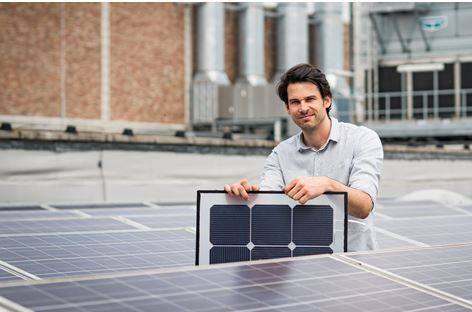

MUNICH, Germany—May 30, 2017—At this week’s Intersolar Europe, imec, the world-leading research and innovation hub in nano-electronics, energy, and digital technology, and partner in EnergyVille, will introduce simulation software that accurately predicts the daily energy yield of solar cells and solar modules under varying meteorological and irradiation conditions. Imec’s model combines optical, thermal and electrical parameters to provide detailed insight on thermal gradients in the solar module. The model integrates the effect of these gradients, resulting in a significantly better accuracy (root mean square error of only 2.5 percent) than commercially available software packages for energy yield estimation.
Solar cell efficiencies and photovoltaic module performances are typically only measured under standard lab conditions. However, in reality, photovoltaic modules are operated in the field under conditions that are substantially different from these standard lab conditions. They are exposed to varying meteorological conditions in terms of irradiation, temperature and wind, which, in addition, all vary during the course of the day. In contrast to most existing models for energy yield calculation, imec’s model starts from the physical parameters of the solar cells and the used materials, and includes on top of that their variations due these changing external conditions. In this way a ‘closer to reality’ model is obtained, enabling a more precise assessment of the effects of solar cell and module technology changes on the energy yield of these photovoltaic cells and modules.
Imec’s simulation software features a coupled optical-thermal-electrical approach and provides detailed insight on thermal gradients in the solar module and their effect on energy yield. The incorporation of wind and thermal transient effects produced a highly accurate calculation of daily energy yield with a root mean square error of only 2.5 percent, under strongly varying meteorological conditions (e.g. clouds passing by, changes in wind speed, ….) compared with the actual measured output. This is significantly better than energy yield calculations that could be obtained using commercial software packages under these varying weather circumstances.
“This record accuracy was obtained thanks to validation tests under controlled circumstances, such as wind tunnels, as well as from detailed data series with fine time granularity from PV modules in the field,” stated Hans Goverde, researcher at imec.
“It is an excellent tool to make a rapid assessment of material and technology changes at the cell and module level and their influence on the levelized cost-of-electricity,” noted Jef Poortmans, scientific director photovoltaics at imec. “Moreover, it is also the ideal starting point to come up with significantly improved short-term energy yield forecasting, which will lead to lower lost opportunity costs and better energy management systems for PV power plants as well as residential solar systems. This means that our model could e.g. become very useful for PV plant operators and electricity grid operators, enabling them to better forecast the short-term varying output of PV power plants, in this way limiting curtailment situations and grid balancing issues, and hence create more value across the full renewable energy value chain.”
Company expands AI order-taking solution to tackle rising labor costs and improve customer experience Hi…
Outperforming competitors like OpenAI and ElevenLabs across standard datasets and specialized jargon recognition, Jargonic sets…
NVIDIA announced KAI Scheduler, the open-source version of the NVIDIA Run:ai Scheduler, available as a…
Partnership will deliver revolutionary, emissions-free travel in the UK, including greater connectivity for Virgin Atlantic…
New Vicor DCM3717 and DCM3735 DC-DC power modules support the growing trend of 48V-centric power…
DigiKey, a leading global commerce distributor offering the largest selection of technical components and automation…